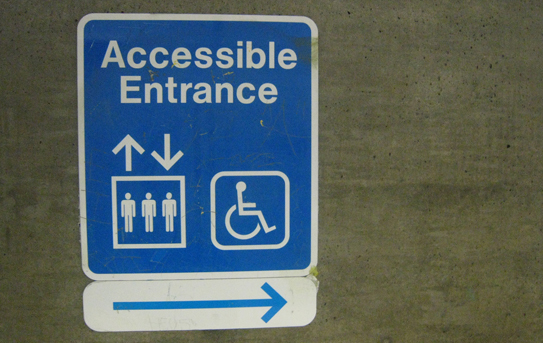 The Americans with Disabilities Act (ADA) Accessibility Guidelines specifically addresses how businesses must do everything possible to welcome customers who need wheelchairs for mobility. Test your knowledge on ADA wheelchair rules as well as the 2010 ADA Standards for Accessible Design. Hint: Our two past multiple-choice question blogs were kind of easy. This one is a bit more challenging, so don’t peek at the answer key!
The Americans with Disabilities Act (ADA) Accessibility Guidelines specifically addresses how businesses must do everything possible to welcome customers who need wheelchairs for mobility. Test your knowledge on ADA wheelchair rules as well as the 2010 ADA Standards for Accessible Design. Hint: Our two past multiple-choice question blogs were kind of easy. This one is a bit more challenging, so don’t peek at the answer key!
1. Businesses must allow people with disabilities to use wheelchairs:
a. only in reasonably accessible locations of their business.
b. in every location except publicly accessible restrooms.
c. in all areas where customers are allowed to go.
d. none of the above.
2. What one barrier can make it impossible for individuals using wheelchairs to do business at a store?
a. a small step at the entrance.
b. doors that do not automatically open.
c. a majority of entrances that are not wheelchair accessible.
d. all of the above.
3. A business with several entrances where only one is wheelchair accessible must:
a. post a sign at the inaccessible entrance directing individuals to the accessible entrance.
b. make all entrances wheelchair accessible.
c. have employees standing by to assist customers wanting access to all entrances.
d. post a sign at the accessible entrance only.
4. The ADA 2010 building construction standards have new requirements. If a business was built or altered in the past 20 years in compliance with the 1991 Standards, the business:
a. Has five years to upgrade its facilities to comply with 2010 Standards.
b. does not have to make further modifications to comply with 2010 Standards.
c. must only upgrade its van parking accommodations to meet the 2010 Standards.
d. must begin to immediately comply with the new 2010 Standards.
5. The revised 2010 ADA Standards have new requirements that were never mentioned in the 1991 standards. These new requirements apply to the following, which must now comply with the new 2010 Standards:
a. swimming pools and play areas
b. exercise machines
c. miniature golf facilities and bowling alleys
d. all of the above
Answer key:
1 – c. More than 50 million Americans are disabled and are living independently in our communities. They want to patronize stores and shops that accommodate them.
2 – a. That one step at a store’s entrance can be the major barrier to accessibility for wheelchair customers.
3 – a. That’s right. If any entrance is not accessible via a wheelchair, the business must post a sign indicating where the accessible entrance is located.
4 – b. If a business was built or altered during the past 20 years and complies with 1991 Standards, no further modifications are needed, even if the new 2010 standards h ave different requirements.
5 – d. Since the 1991 Standards never addressed recreation facilities, those facilities are not exempt from the 2010 Standards. They include, among others, amusement rides, fishing piers and platforms, golf facilities, saunas and steam rooms, and recreational boating areas.
Know your rights
For further information on what small businesses must do to accommodate people with disabilities, see the ADA Update: A primer for Small Business. Wondering whether your rights have been violated? Contact us. We are the leader in ADA building compliance, and we can help.
